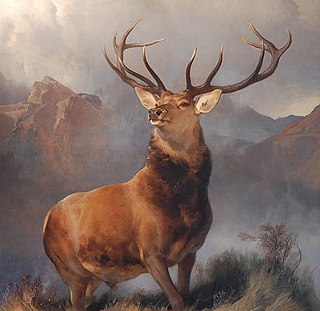The Monarch of the Glen (painting)
 |
|
| Artist | Sir Edwin Landseer |
|---|---|
| Year | 1851 |
| Medium | Oil-on-canvas |
| Location | National Museum of Scotland, Edinburgh (as loan from Diageo) |
The Monarch of the Glen is an oil-on-canvas painting of a red deer stag completed in 1851 by the English painter Sir Edwin Landseer, which was commissioned as part of a series of three panels to hang in the Palace of Westminster in London. It was one of the most popular paintings throughout the 19th century, and reproductions in steel engraving sold very widely, and the painting itself was finally bought by companies to use in advertising. The painting had become something of a cliché by the mid-20th century, as "the ultimate biscuit tin image of Scotland: a bulky stag set against the violet hills and watery skies of an isolated wilderness", according to the Sunday Herald.
The painting is reportedly set in Glen Affric.
The stag has twelve points on his antlers, which in deer terminology makes him a "royal stag" but not a "monarch stag", for which sixteen points are needed.
Landseer was a member of the Royal Academy, a favourite of Queen Victoria, and had become famous for his paintings and drawings of animals. His later works include the sculptures of the lions at the foot of Nelson's Column in Trafalgar Square. From the 1840s, he produced a series of intricately observed studies of stags based on those he had seen on the trips he had been making to the Scottish Highlands since 1824. In 1850 Landseer received a national commission to paint three subjects connected with the chase for the Refreshment Rooms of the House of Lords, for which he produced Monarch of the Glen and two other paintings. Once they were completed the House of Commons refused to grant the £150 promised for the commission, and, as a result, the paintings were sold to private collectors.
It was exhibited in London in 1851, 1874 and 1890. From the collection of William Denison, 1st Earl of Londesborough it passed in 1884 to Henry Eaton, 1st Baron Cheylesmore after whose death in 1891 it realized £7,245 at his sale at Christie's in May 1892, where it was bought by Agnew's, who resold it to T. Barratt for £8,000. In 1916 he resold it at Christie's for £5,250. The price in 1892 was the highest made by a Landseer before the 1960s, with the exception of a rumoured price of £10,000 in a private sale of The Otter Hunt in 1873, which would have then represented the highest price ever paid for a British picture.
...
Wikipedia
